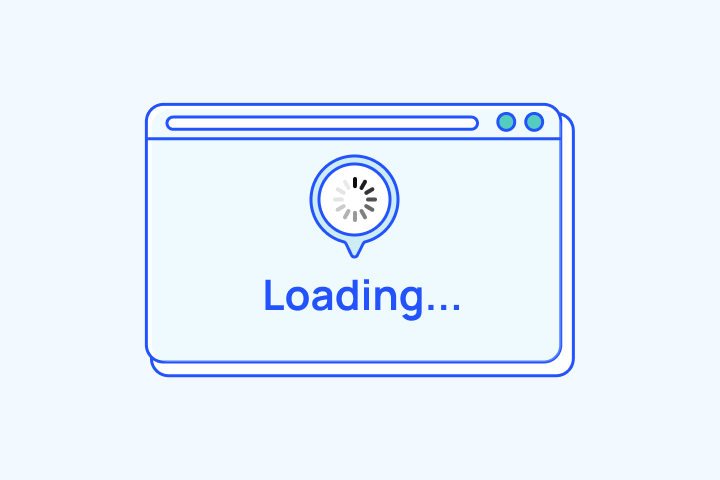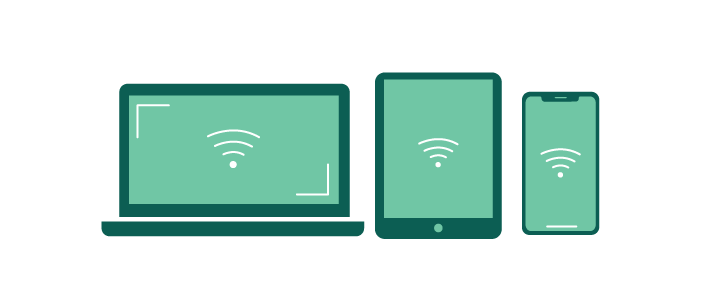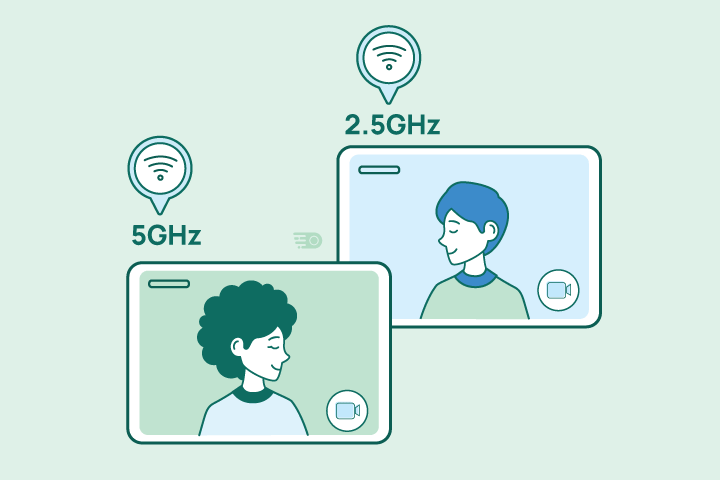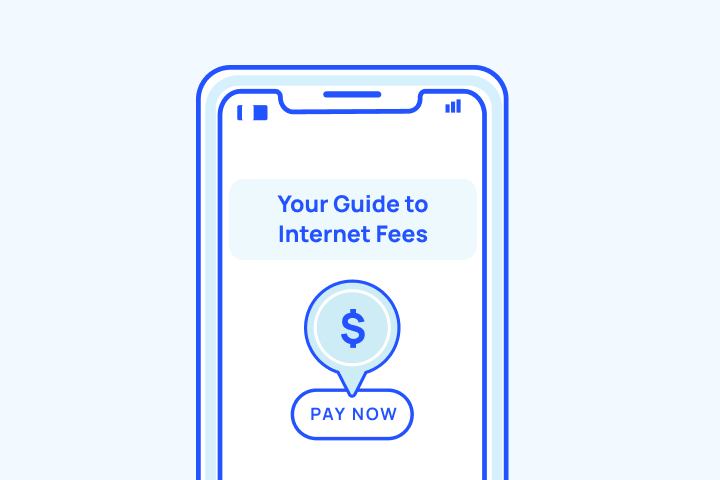Your Guide to Internet Data Caps

HighSpeedOptions prides itself on providing honest, quality content. While we may be compensated when you make a purchase through links on our site, all opinions are our own. Here's how we make money.
Table of Contents
Few things are more frustrating than an unexpectedly high internet bill. Hidden fees and data overages are common, but you don’t have to be caught off guard.
It’s not uncommon for internet providers to have data caps on their home internet service. Yet, going over those limits could cost a lot, depending on which provider you have.
Be in the know about who has internet data caps, who doesn’t, and what you need to do to avoid this unwanted fee.
Internet Data Caps Key Takeaways
- Not all providers use data caps. Fiber providers like Verizon Fios and Frontier typically offer unlimited data, while cable providers often enforce 1–1.5 TB caps with overage fees.
- Satellite internet works differently. Providers like HughesNet and Viasat don’t charge overages but slow your connection once you exceed your high-speed data allowance.
- Household activity matters. 4K streaming, frequent video calls, and large game updates can quickly push a family past a 1 TB cap.
- You can manage usage. Lowering streaming quality, staggering downloads, and enabling data saver modes help stretch your monthly allowance.
- Unlimited may be worth it. If you regularly exceed your cap, upgrading to unlimited (or switching to a no-cap provider) is usually cheaper and less stressful than paying overage fees.

What is an Internet Data Cap?
A data cap is a monthly limit that your internet provider places on the data you can transfer with your connection. But not all providers impose them. Your internet plan might include unlimited data, in which case, our feelings won’t be hurt if you exit from this article now.
If you exceed your provider’s data cap or limit, they can charge you an additional fee. These overage fees are usually billed in chunks, say, $10 for every 50 GB over the limit. Alternatively, you may experience internet throttling if your provider doesn’t charge overage fees but does have data limits.
What is Speed Throttling?
Speed throttling is when your provider intentionally slows down your internet speeds after you’ve hit your data cap. Not all providers do this, yet it’s very common as an alternative to–or in conjunction with–overage fees.
Even if you have unlimited data, internet providers may use speed throttling as a way to regulate their networks and avoid user congestion. This is especially common during peak internet traffic hours between 7:00 PM and 11:00 PM. Yes, right in the middle of bingeing your favorite Netflix show.
If you consistently exceed your internet data cap, consider upgrading to a higher data allowance or switching to a provider like Spectrum internet that offers unlimited data.
Why Providers Use Data Caps

The main purpose data caps serve is to help providers regulate their network traffic and manage congestion. This ensures that all customers have equal access and internet performance across the board.
Some providers know that it’s a balancing act. Most data caps amount to 1 TB/mo., which is generally enough data for the average U.S. household. As some customers use more data than others, providers like Frontier and Verizon do not enforce data limits.
Satellite Internet Data Limits
While most internet providers handle data limits in one way, Satellite internet data caps work differently. With fiber internet or cable internet, there’s usually a specific amount of data you can use in a month before facing overage fees, typically around 1TB.
However, satellite internet providers advertise unlimited total data per month, but high-speed internet is capped. Starlink provides unlimited data at any speed, but may reduce speeds during peak hours. The idea is to manage costs and traffic, so satellite providers restrict the amount of high-speed data you can use in a month.
You may not get charged for going over the limit. Your connection will be slower once you’ve used up your high-speed data, but you can still check email, browse the internet, and read the news. So, save your high-speed satellite internet data usage for activities like working from home, streaming HD videos, or gaming online.
Data Usage by Online Activity
Data usage measures how much data is required to perform an online task. As we discussed above, some internet providers impose data limits to manage network performance. If you don’t have unlimited data and want to avoid pesky overage fees, start thinking in terms of how much data you regularly use.
The FCC recommends a minimum of 25 Mbps for one user, but you may need a higher bandwidth as you connect more devices. And you certainly need more if your household has multiple users. Today, most starter internet packages begin at speeds up to 50 Mbps – 100 Mbps for this reason.
Use the estimates below to estimate the speed and data allowance you need for the best online experience.
| General Activities | Data Per Hour | Required Speed |
| Basic Web Browsing | 20 MB | 1 Mbps |
| 50 MB | 1 Mbps | |
| Social Media | 150 MB | 1 Mbps |
| Download Photos | 5 MB each photo | 3 Mbps |
| Upload Photos | 5 MB each photo | 25 Mbps |
| Telecommuting | 1 GB | 25 Mbps |
| Online Classes | 1 GB | 25 Mbps |
| General Activities | Basic Web Browsing |
| Data Per Hour | 20 MB |
| Required Speed | 1 Mbps |
| General Activities | |
| Data Per Hour | 50 MB |
| Required Speed | 1 Mbps |
| General Activities | Social Media |
| Data Per Hour | 150 MB |
| Required Speed | 1 Mbps |
| General Activities | Download Photos |
| Data Per Hour | 5 MB each photo |
| Required Speed | 3 Mbps |
| General Activities | Upload Photos |
| Data Per Hour | 5 MB each photo |
| Required Speed | 25 Mbps |
| General Activities | Telecommuting |
| Data Per Hour | 1 GB |
| Required Speed | 25 Mbps |
| General Activities | Online Classes |
| Data Per Hour | 1 GB |
| Required Speed | 25 Mbps |
| Video Activities | Data Per Hour | Required Speed |
| SD Video Streaming | 1 GB | 4 Mbps |
| HD Video Streaming | 3 GB | 8 Mbps |
| Ultra HD 4K Video Streaming | 7 GB | 25 Mbps |
| HD Video Calls | 350 MB | 2 Mbps |
| Video Activities | SD Video Streaming |
| Data Per Hour | 1 GB |
| Required Speed | 4 Mbps |
| Video Activities | HD Video Streaming |
| Data Per Hour | 3 GB |
| Required Speed | 8 Mbps |
| Video Activities | Ultra HD 4K Video Streaming |
| Data Per Hour | 7 GB |
| Required Speed | 25 Mbps |
| Video Activities | HD Video Calls |
| Data Per Hour | 350 MB |
| Required Speed | 2 Mbps |
| Gaming Activities | Data Per Hour | Required Speed |
| Gaming – Single Player | 40 MB | 3 Mbps |
| Gaming – MultiPlayer | 60 MB | 4 Mbps |
| Gaming Activities | Gaming â Single Player |
| Data Per Hour | 40 MB |
| Required Speed | 3 Mbps |
| Gaming Activities | Gaming â MultiPlayer |
| Data Per Hour | 60 MB |
| Required Speed | 4 Mbps |
Difference Between ‘Bits’ and ‘Bytes’
Speed is measured in bits (Mbps), while data usage is measured in bytes (MB, GB). Since 8 bits = 1 byte, your internet speed number (in Mbps) will always look larger than your data usage number (in MB or GB).
If you want to track your usage to avoid overage fees, many providers have data trackers in your profile or account details. It’s important to note that the maximum speed on your plan has no bearing on the amount of data you use. The main factor is the amount of data you are downloading or uploading. This is what your internet data cap is based on – the bytes.
Compare Data Caps by Internet Provider
Most providers offer a mix of internet data caps and unlimited data options, depending on where you live and which plan you go with. If your provider does place data caps on plans to start, be sure to ask if there is an option to purchase unlimited data for an additional monthly cost.
| Provider | Data Caps? | Cap Size | Overage Fees | Unlimited Option |
| AT&T | Yes (non-fiber); No (fiber) | ~1.5 TB (non-fiber) | $10 / 50 GB (max ~$100) | $30/mo add-on |
| Buckeye Broadband | Yes | Varies by plan | Fee per 50 GB | $30/mo add-on |
| CenturyLink | No (current plans) | Unlimited | None | N/A |
| Cox | Yes | 1.25 TB | $10 / 50 GB (max ~$100) | Unlimited add-on (~$50/mo; sometimes included with bundles) |
| Mediacom (Xtream) | Yes (many plans) | 150 GB – 6 TB | $10 / 50 GB | Market-dependent; some “no cap” plans |
| Rise Broadband | No | Unlimited | None | N/A |
| WOW! | No | Unlimited | None | N/A |
| Xfinity | Some plans capped; others unlimited | 1.2 TB (legacy) / Unlimited (new) | $10 / 50 GB (max ~$100) | Unlimited via xFi Complete or included on new plans |
| RCN (Astound) | Mostly No; some caps in regions | Market-specific | $6.50 / 25 GB (where enforced) | N/A |
| EarthLink | Varies by product | Fiber: Unlimited; Wireless/Satellite: capped | No overages (slowed or buy tokens) | Buy extra data tokens (non-fiber) |
| Frontier | No | Unlimited | None | N/A |
| HughesNet | Yes (high-speed data) | Plan-specific Priority Data | None (slows after cap) | Data tokens available |
| MetroNet | No | Unlimited | None | N/A |
| Midco | No | Unlimited | None | N/A |
| Optimum | No | Unlimited | None | N/A |
| Smithville | No | Unlimited | None | N/A |
| Spectrum | No | Unlimited | None | N/A |
| Kinetic by Windstream | No | Unlimited | None | N/A |
| Verizon Fios | No | Unlimited | None | N/A |
| Viasat | Yes (high-speed data) | Plan-dependent (e.g., 150 GB+) | None (slows after cap) | Switch plans; no true unlimited add-on |
| Provider | AT&T |
| Data Caps? | Yes (non-fiber); No (fiber) |
| Cap Size | ~1.5 TB (non-fiber) |
| Overage Fees | $10 / 50 GB (max ~$100) |
| Unlimited Option | $30/mo add-on |
| Provider | Buckeye Broadband |
| Data Caps? | Yes |
| Cap Size | Varies by plan |
| Overage Fees | Fee per 50 GB |
| Unlimited Option | $30/mo add-on |
| Provider | CenturyLink |
| Data Caps? | No (current plans) |
| Cap Size | Unlimited |
| Overage Fees | None |
| Unlimited Option | N/A |
| Provider | Cox |
| Data Caps? | Yes |
| Cap Size | 1.25 TB |
| Overage Fees | $10 / 50 GB (max ~$100) |
| Unlimited Option | Unlimited add-on (~$50/mo; sometimes included with bundles) |
| Provider | Mediacom (Xtream) |
| Data Caps? | Yes (many plans) |
| Cap Size | 150 GB â 6 TB |
| Overage Fees | $10 / 50 GB |
| Unlimited Option | Market-dependent; some âno capâ plans |
| Provider | Rise Broadband |
| Data Caps? | No |
| Cap Size | Unlimited |
| Overage Fees | None |
| Unlimited Option | N/A |
| Provider | WOW! |
| Data Caps? | No |
| Cap Size | Unlimited |
| Overage Fees | None |
| Unlimited Option | N/A |
| Provider | Xfinity |
| Data Caps? | Some plans capped; others unlimited |
| Cap Size | 1.2 TB (legacy) / Unlimited (new) |
| Overage Fees | $10 / 50 GB (max ~$100) |
| Unlimited Option | Unlimited via xFi Complete or included on new plans |
| Provider | RCN (Astound) |
| Data Caps? | Mostly No; some caps in regions |
| Cap Size | Market-specific |
| Overage Fees | $6.50 / 25 GB (where enforced) |
| Unlimited Option | N/A |
| Provider | EarthLink |
| Data Caps? | Varies by product |
| Cap Size | Fiber: Unlimited; Wireless/Satellite: capped |
| Overage Fees | No overages (slowed or buy tokens) |
| Unlimited Option | Buy extra data tokens (non-fiber) |
| Provider | Frontier |
| Data Caps? | No |
| Cap Size | Unlimited |
| Overage Fees | None |
| Unlimited Option | N/A |
| Provider | HughesNet |
| Data Caps? | Yes (high-speed data) |
| Cap Size | Plan-specific Priority Data |
| Overage Fees | None (slows after cap) |
| Unlimited Option | Data tokens available |
| Provider | MetroNet |
| Data Caps? | No |
| Cap Size | Unlimited |
| Overage Fees | None |
| Unlimited Option | N/A |
| Provider | Midco |
| Data Caps? | No |
| Cap Size | Unlimited |
| Overage Fees | None |
| Unlimited Option | N/A |
| Provider | Optimum |
| Data Caps? | No |
| Cap Size | Unlimited |
| Overage Fees | None |
| Unlimited Option | N/A |
| Provider | Smithville |
| Data Caps? | No |
| Cap Size | Unlimited |
| Overage Fees | None |
| Unlimited Option | N/A |
| Provider | Spectrum |
| Data Caps? | No |
| Cap Size | Unlimited |
| Overage Fees | None |
| Unlimited Option | N/A |
| Provider | Kinetic by Windstream |
| Data Caps? | No |
| Cap Size | Unlimited |
| Overage Fees | None |
| Unlimited Option | N/A |
| Provider | Verizon Fios |
| Data Caps? | No |
| Cap Size | Unlimited |
| Overage Fees | None |
| Unlimited Option | N/A |
| Provider | Viasat |
| Data Caps? | Yes (high-speed data) |
| Cap Size | Plan-dependent (e.g., 150 GB+) |
| Overage Fees | None (slows after cap) |
| Unlimited Option | Switch plans; no true unlimited add-on |
*Prices, availability, and data limits vary by location and are subject to change. Additional fees and terms may apply. Information sourced 09/08/2025.
Impact of Streaming and Gaming on Internet Data Use
Understanding the numbers in a table is helpful, but real-world scenarios make data usage easier to grasp. Streaming video and online gaming are two of the biggest drivers of high data consumption in most households:
Streaming video
Ultra HD/4K streaming can use up to 7 GB per hour per stream. A family of four watching their favorite shows in 4K every evening could burn through 1 TB of data in just 2–3 weeks. Even switching to HD (1080p) can cut usage by more than half.
Online gaming
Contrary to popular belief, online gameplay itself doesn’t use much data—usually only 40–150 MB per hour. However, game downloads and updates are where the data adds up. New titles and patches often range from 50–100 GB each, meaning a single update can rival an entire month of light web browsing.
Video calls and live streaming
Platforms like Zoom, Teams, or Twitch add to the mix. A daily HD video call can use 1–3 GB per hour, while livestreaming at high resolution can push data usage into the same territory as video streaming.
It’s easy to hit a provider’s data limit. Even if your household isn’t constantly downloading or gaming, a mix of 4K streaming, video calls, and game updates can push you close to—or past—common data caps faster than you might expect.
Unlimited Data vs. Overage Fees: Is It Worth It?
Most providers that enforce internet data caps offer two options: pay overage fees when you exceed your limit, or add an unlimited data option for a flat monthly fee (usually $30–$50).
- Overage fees: Vary by provider, but typically $10 for every 50 GB over your data cap; some providers charge a monthly fee instead. Light users who only go over occasionally may find this more cost-effective than paying for unlimited every month.
- Unlimited add-ons: For households that consistently stream in 4K, work from home, or download large files, paying a flat fee for unlimited data often saves money and eliminates surprise bills.
- Rule of thumb: If you exceed your cap more than two or three times per year, or if your overage charges average $30 or more per month, upgrading to unlimited is usually the better deal.
How to Reduce Internet Data Usage
If your internet plan has a data cap, the best way to avoid surprise overage fees or throttling is to manage your monthly usage wisely. Fortunately, small adjustments can make a big difference.
Stream at a lower quality
Watching Netflix or YouTube in 4K can use 7 GB of data per hour. Switching to HD (1080p) or even SD for casual viewing can stretch your allowance further.
Use data saver modes
Many streaming apps, gaming platforms, and even web browsers include “data saver” or “low data” settings. Enabling these can automatically reduce resolution or background activity.
Schedule large downloads off-peak
Game updates, operating system patches, and software installs often run 20–100 GB or more. Schedule them overnight or when fewer devices are connected to avoid congestion and manage your usage more predictably.
Adjust auto-update settings
Prevent devices from downloading updates simultaneously by staggering updates across your household. Turning off automatic updates for apps you rarely use can also help.
Download content for offline use
Save playlists, podcasts, or shows while on Wi-Fi at work, school, or a café. Watching downloaded content uses no additional data once stored on your device.
Limit background activity
Cloud backups, security cameras, and smart devices can quietly consume large amounts of data. Review your device settings and disable unnecessary background uploads.
By combining these strategies, you can maximize your data plan, minimize the risk of extra fees, and still enjoy a seamless online experience.
Should You Cap or Go Unlimited?
Internet data caps affect households differently. If your online activity is light — browsing, email, or the occasional HD stream — you may never bump into a monthly cap. But for families with multiple streamers, remote workers, or gamers, hitting those limits can quickly become a recurring frustration.
The bottom line:
- Know your provider’s policy. Check whether your plan has a hard cap, throttling rules, or truly unlimited data.
- Track your usage. Use provider dashboards, router tools, or third-party apps to avoid surprises.
- Decide what’s right for you. If you regularly approach your data limit, upgrading to an unlimited plan or switching to a no-cap provider is often the most cost-effective solution.
With the right plan and a few smart usage habits, you can keep your household connected without worrying about slowdowns or unexpected fees.
Frequently Asked Questions About Internet Data Caps
A data cap, sometimes called a data limit or internet data cap, is the maximum amount of internet data your internet provider allows you to use each month. If you exceed that limit, you may face overage fees or experience speed throttling.
Internet providers set data caps to manage network traffic and reduce congestion. By limiting heavy usage, they can keep speeds more consistent across all customers while managing network performance.
You can stay under your internet data cap by lowering video streaming quality, turning on data saver modes, scheduling large downloads during off-peak hours, and monitoring your monthly usage with your provider’s app or dashboard.
No. Spectrum internet plans include unlimited data with no data caps, so you won’t face overage fees or throttling based on your total usage.
Satellite internet providers like HughesNet and Viasat advertise unlimited internet data, but they place limits on high-speed data. Once you use your monthly allowance, your speeds are reduced (throttled) for the rest of the billing cycle. Unlike cable internet providers, they typically don’t charge overage fees — you can keep using the internet, just at slower speeds. Starlink works a bit differently: it offers unlimited high-speed data, but speeds may be temporarily reduced during peak congestion periods.
Many cable providers, such as Cox and Xfinity, impose data caps around 1–1.5 TB per month, with fees of about $10 per 50 GB if you exceed your limit. Fiber providers like Verizon Fios and Frontier generally offer unlimited data with no caps.
Work-from-home activities can add up quickly against a monthly internet data cap. An HD Zoom or Teams call uses about 1–3 GB per hour, while a virtual private network (VPN) connection can consume up to 1 GB per hour, depending on activity. Cloud storage and file sharing may use 10–100 GB per month or more if you regularly upload or sync large files. For remote workers, especially in households with multiple users, an unlimited data plan is often the best way to avoid hitting your data limit.
Most providers offer an online dashboard or mobile app that shows your monthly data usage. You can also check your router’s built-in usage reports or use third-party tools if you want more detailed tracking by device.
No. Verizon Fios and Verizon 5G Home Internet plans do not enforce internet data caps. Customers can use unlimited internet data each month without worrying about overage fees.






